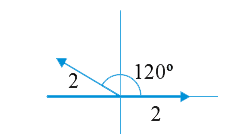When two vectors of magnitudes P and Q are inclined at an angle θ, the magnitudes of their resultant is 2P. When the inclination is changed to 180∘−θ, the magnitudes of the resultant is halved. Find the ratio of P and Q.
The correct Answer is:√2√3
To solve the problem, we will use the properties of vectors and the law of cosines. Let's break it down step by step.
Step 1: Write the equation for the resultant of two vectors at angle θ
When two vectors of magnitudes P and Q are inclined at an angle θ, the magnitude of their resultant R can be given by the formula:
R2=P2+Q2+2PQcosθ
According to the problem, the magnitude of the resultant is 2P. Therefore, we can write:
(2P)2=P2+Q2+2PQcosθ
This simplifies to:
4P2=P2+Q2+2PQcosθ
Step 2: Rearranging the equation
Now, rearranging the above equation gives us:
4P2−P2−Q2=2PQcosθ
This simplifies to:
3P2−Q2=2PQcosθ(Equation 1)
Step 3: Write the equation for the resultant of two vectors at angle 180° - θ
When the angle is changed to 180∘−θ, the cosine term changes to −cosθ. Thus, the resultant R' can be expressed as:
R′2=P2+Q2−2PQcosθ
According to the problem, the magnitude of the resultant is halved, which means:
(2P2)2=P2+Q2−2PQcosθ
This simplifies to:
P2=P2+Q2−2PQcosθ
Step 4: Rearranging the second equation
Rearranging gives us:
P2−P2−Q2=−2PQcosθ
This simplifies to:
−Q2=−2PQcosθ
or
Q2=2PQcosθ(Equation 2)
Step 5: Solve the two equations
Now we have two equations:
1. 3P2−Q2=2PQcosθ (Equation 1)
2. Q2=2PQcosθ (Equation 2)
Substituting Equation 2 into Equation 1:
3P2−2PQcosθ=2PQcosθ
This simplifies to:
3P2=4PQcosθ
Step 6: Express Q in terms of P
Rearranging gives:
Q=3P24Pcosθ=3P4cosθ
Step 7: Find the ratio of P and Q
Now, we can find the ratio of P to Q:
PQ=P3P4cosθ=4cosθ3
Conclusion
Thus, the ratio of P to Q is:
PQ=4cosθ3
When two vectors of magnitudes P and Q are inclined at an angle θ, the magnitude of their resultant R can be given by the formula:
Now, rearranging the above equation gives us:
When the angle is changed to 180∘−θ, the cosine term changes to −cosθ. Thus, the resultant R' can be expressed as:
Rearranging gives us:
Now we have two equations:
2. Q2=2PQcosθ (Equation 2)
Rearranging gives:
Now, we can find the ratio of P to Q:
Thus, the ratio of P to Q is:
Topper's Solved these Questions
- VECTORSBOOK - CENGAGE PHYSICS ENGLISHCHAPTER - VECTORSEXERCISE - Exercise Single Correct
51 Videos
- VECTORSBOOK - CENGAGE PHYSICS ENGLISHCHAPTER - VECTORSEXERCISE - Exercise Multiple Correct
5 Videos
- VECTORSBOOK - CENGAGE PHYSICS ENGLISHCHAPTER - VECTORSEXERCISE - Exercise 3.2
13 Videos
- TRAVELLING WAVESBOOK - CENGAGE PHYSICS ENGLISHCHAPTER - TRAVELLING WAVESEXERCISE - Integer
9 Videos
- WORK, POWER & ENERGYBOOK - CENGAGE PHYSICS ENGLISHCHAPTER - WORK, POWER & ENERGYEXERCISE - Archives (integer)
4 Videos
Similar Questions
Two forces of magnitudes P and Q are inclined at an angle (θ). The magnitude of their resultant is 3Q. When the inclination is changed to (180∘−θ), the magnitude of the resultant force becomes Q. Find the ratio of the forces.
View SolutionTwo vectors having magnitude 12 and 13 are inclined at and angle45∘ to each other.find their resultant vector.
View SolutionWhen two right angled vectors of magnitude 7 units and 24 units combine, what is the magnitude of their resultant ?
View SolutionWhen two vectors a and b of magnitudes 'a' and 'b' respectively are added, the magnitude of resultant vector is always
View SolutionIf three unit vectors are inclined at an angle of 60∘ with each other, then the magnitude of their resultant vector will be
View SolutionTwo equal forces of magnitude 'p' each are angled first at 60° later at 120°. The ratio of magnitude of their resultants is
View SolutionResultant of two vector of equal magnitude A is
View SolutionFind the magnitude and direction of the resultant of given vectors

View SolutionTwo forces are such that the sum of their magnitudes is 18 N, the resultant is √228 when they are at 120∘. Then the magnitude of the forces are
View SolutionA vector →r is inclined at equal angle to the three axes. If the magnitude of →r is 2√3 find →r
View Solution
